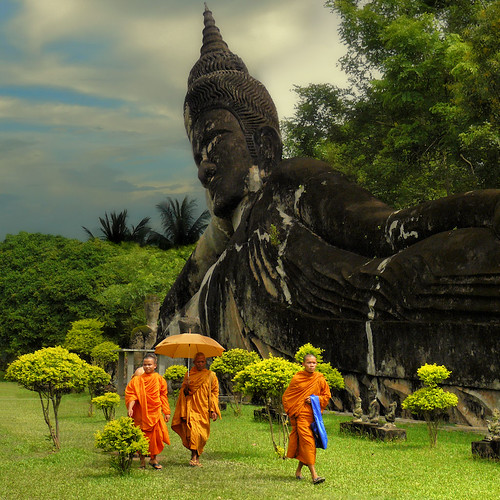Photo: Buddhist monks passing the enormous reclining Buddha; the Buddha's final state of enlightenment: their lifestyle is shaped so as to support their spiritual practice, to live a simple and meditative life.
Xieng Khuan is a Buddha park located 25 km southeast from Vientiane, Laos, in a meadow by the Mekong River. It may be referred to as Wat Xieng Khuan. The name Xieng Khuan means Spirit City. The park was built by Luang Pu (Venerable Grandfather) Bunleua Sulilat. Luang Pu Bunleua Sulilat was a priest-shaman who integrated Hinduism and Buddhism. At the top, there is a vantage point where the entire park is visible. An enormous 40 m high reclining Buddha, is also a park attraction. The reclining posture may represent the Buddha resting or sleeping, but more usually represents the mahāparinabbāna: the Buddha's final state of enlightenment before his death.
Uploaded on 14 Nov 08, 8.44AM PDT, text and photo by Ben.
Wednesday, April 28, 2010
Xieng Khuan Buddha Park
Thursday, April 1, 2010
Bodhi Tree at the Sri Mahabodhi Temple
Photo: The Bodhi Tree (Sacred Fig) at the Sri Mahabodhi Temple propagated from the Sri Maha Bodhi, which in turn was propagated from the original Bodhi Tree. The Mahabodhi Temple is at the spot where the Buddha attained enlightenment.
The Bodhi Tree is a large very old Sacred Fig tree (Ficus religiosa) located in Bodh Gaya, about 100 km from Patna, Bihar. Under this tree Lord Buddha achieved enlightenment or Bodhi. It is believed it will take 100 to 3,000 years for a bodhi tree to grow fully.
The Sacred Fig or Bo-Tree is a species of banyan fig native to Bangladesh, India, Nepal, Sri Lanka, southwest China and Indochina. This tree is considered sacred by the followers of Hinduism, Jainism and Buddhism. The tree is well-known symbol for happiness, prosperity, longevity and good luck. Today in India, Hindu sadhus still meditate below this tree, and in Theravada Buddhist Southeast Asia, the tree's massive trunk is often the site of Buddhist shrines.
The fig tree is known by various local names in Indian languages such as pipal (also spelt as peepal, peepul, pippala, etc) in Hindi, pimpald in Marathi, assattha or rukkha in Pali, kaṇavam or arasa maram in Tamil, arayal in Malayalam, asbattha or peepal in Bengali, raavi or raagi in Telugu and arali in Kannada.
The Bodhi Tree is believed to be a direct descendant of the original banyan tree under which Budha used to meditate. This tree is a destination for pilgrims because it is the most important of the four main Buddhist pilgrimage sites. Other holy Bodhi trees in the history of Buddhism are the Anandabodhi tree in Sravasti (in the present day's Gonda district of Uttar Pradesh, India) and the Bodhi tree in Anuradhapura, Sri Lanka. Both are believed to have been propagated from the original Bodhi tree.
According to Buddhist texts the Buddha, after his Enlightenment, spent a whole week in front of the tree, standing with unblinking eyes, gazing at it with gratitude. A shrine was later erected on the spot where he stood.
According to the Mahavamsa, the Sri Maha Bodhi in Sri Lanka was planted in 288 BC, making it the oldest verified specimen of any angiosperm. The right branch of the Bodhi tree was brought by Sanghamitra, the daughter of Emperor Ashoka and his Buddhist queen Devi, to Anuradhapura and placed by Devānāmpiyatissa in the Mahāmeghavana.

